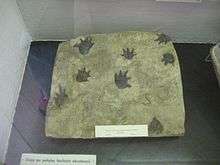Ichnite
-PaleozoologicalMuseumOfChina-May23-08.jpg)
An ichnite (Greek "ιχνιον" (ichnion) – a track, trace or footstep) is a fossilised footprint. This is a type of trace fossil. Over the years, many ichnites have been found, around the world, giving important clues about the behaviour (and foot structure and stride) of the animals that made them. For instance, multiple ichnites of a single species, close together, suggest 'herd' or 'pack' behaviour of that species.
Combinations of footprints of different species provide clues about the interactions of those species. Even a set of footprints of a single animal gives important clues, as to whether it was bipedal or quadrupedal. In this way, it has been suggested that some pterosaurs, when on the ground, used their forelimbs in an unexpected quadrupedal action.
Special conditions are required, in order to preserve a footprint made in soft ground (such as an alluvial plain or a formative sedimentary deposit). A possible scenario is a sea or lake shore that became dried out to a firm mud in hot, dry conditions, received the footprints (because it would only have been partially hardened and the animal would have been heavy) and then became silted over in a flash storm.
The first ichnite found was in 1800 in Massachusetts, USA, by a farmer named Pliny Moody, who found 1-foot (31 cm) long fossilized footprints. They were thought by Harvard and Yale scholars to be from "Noah's Raven." [1]
A famous group of ichnites was found in a limestone quarry at Ardley, 20 km Northeast of Oxford, England, in 1997. They were thought to have been made by Megalosaurus and possibly Cetiosaurus. There are replicas of some of these footprints, set across the lawn of Oxford University Museum of Natural History (OUMNH).
A creature named Cheirotherium was, for a long time and still may be, only known from its fossilised trail. Its footprints were first found in 1834, in Thuringia, Germany, dating from the Late Triassic Period.
Gallery of images
-
Cheirotherium trace fossil, displayed in Oxford University Museum of Natural History.
-

Cross-section of Pleistocene mammoth footprints at The Mammoth Site, Hot Springs, South Dakota.
-
Eubrontes, a dinosaur footprint in the Lower Jurassic Moenave Formation at the St. George Dinosaur Discovery Site at Johnson Farm, southwestern Utah.
-

Cameloid footprint (Lamaichnum alfi Sarjeant and Reynolds, 1999; convex hyporelief) from the Barstow Formation (Miocene) of Rainbow Basin, California.
-

Saurichnites intermedius
References
External links
- Texts on natural casts of dinosaur tracks found in Utah coal mines
 "Fossil Footprints". The American Cyclopædia. 1879.
"Fossil Footprints". The American Cyclopædia. 1879.